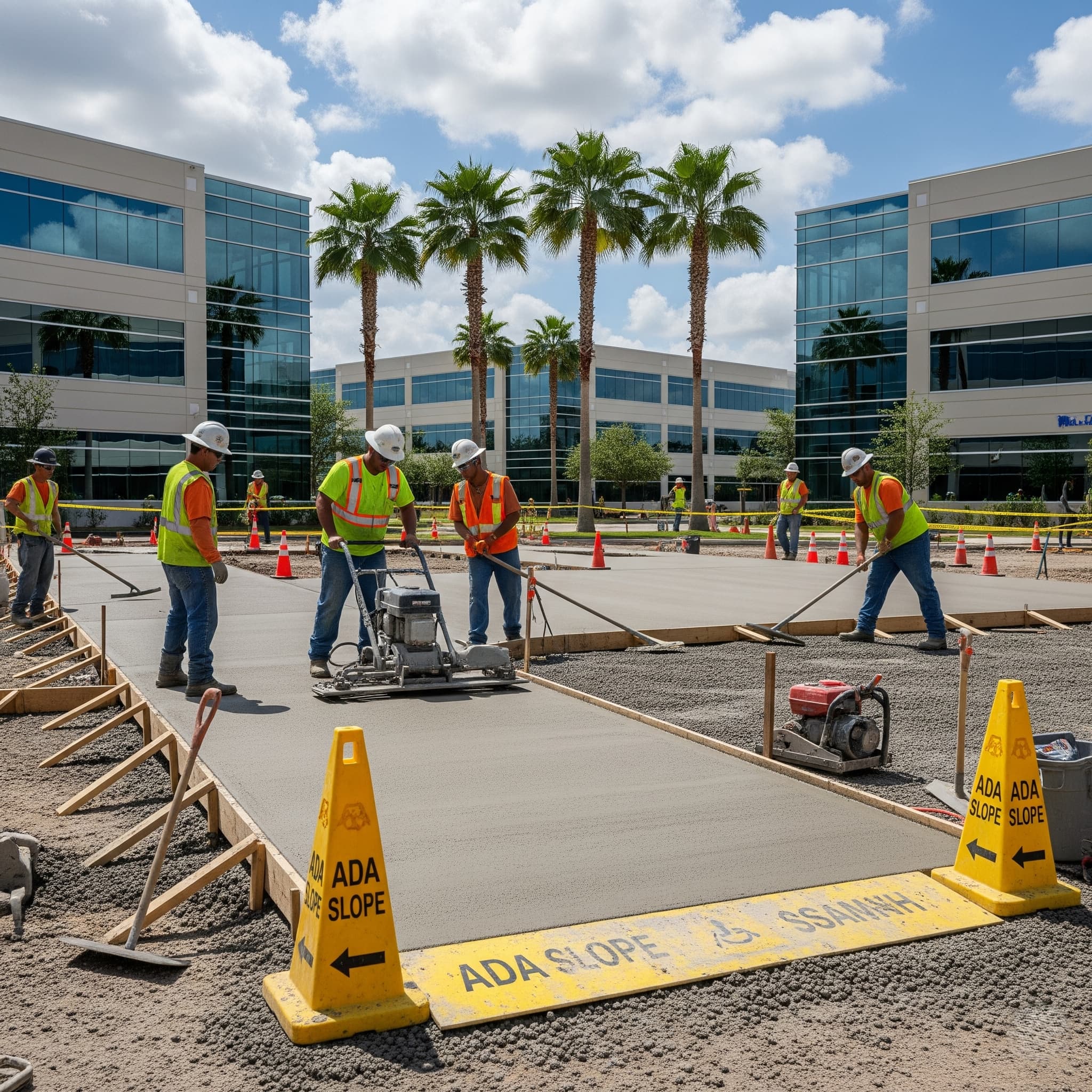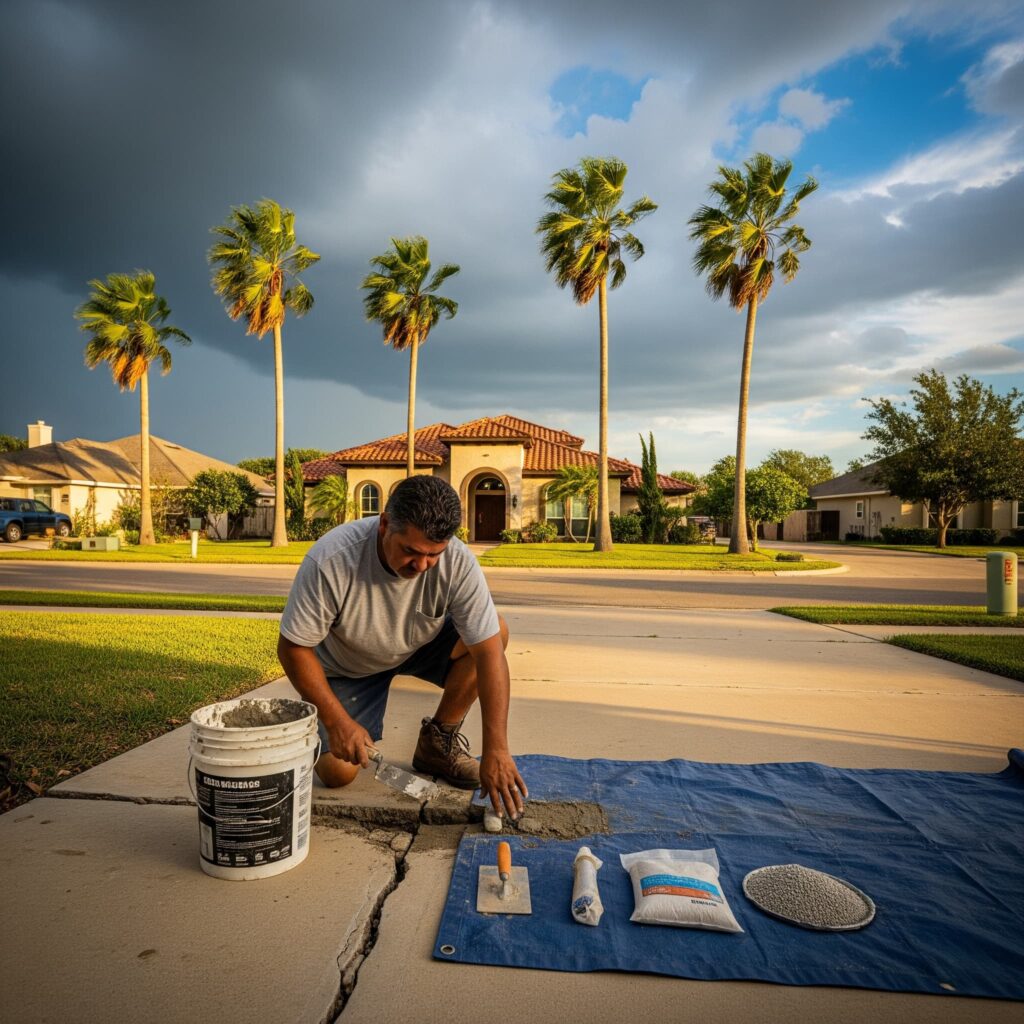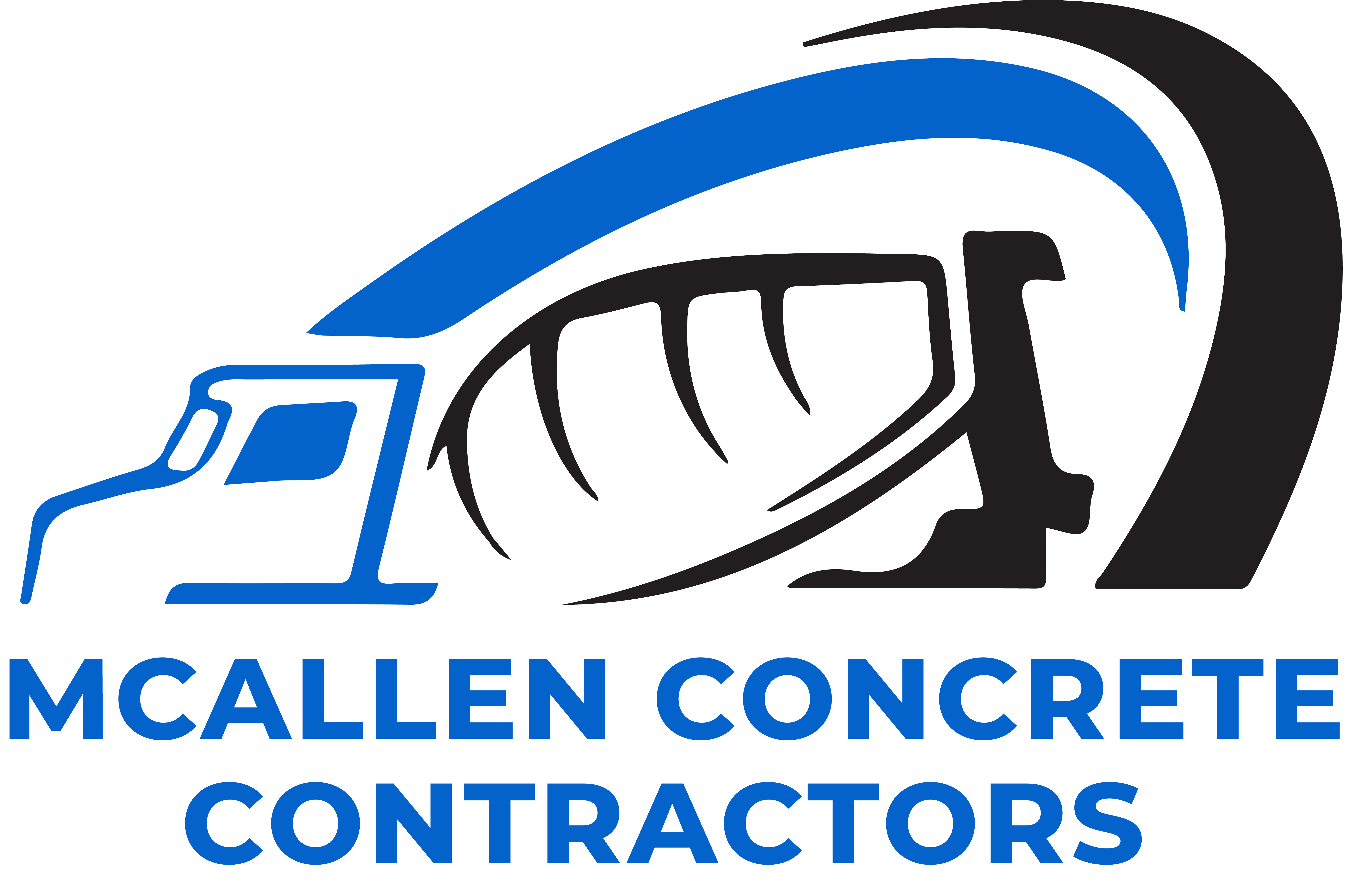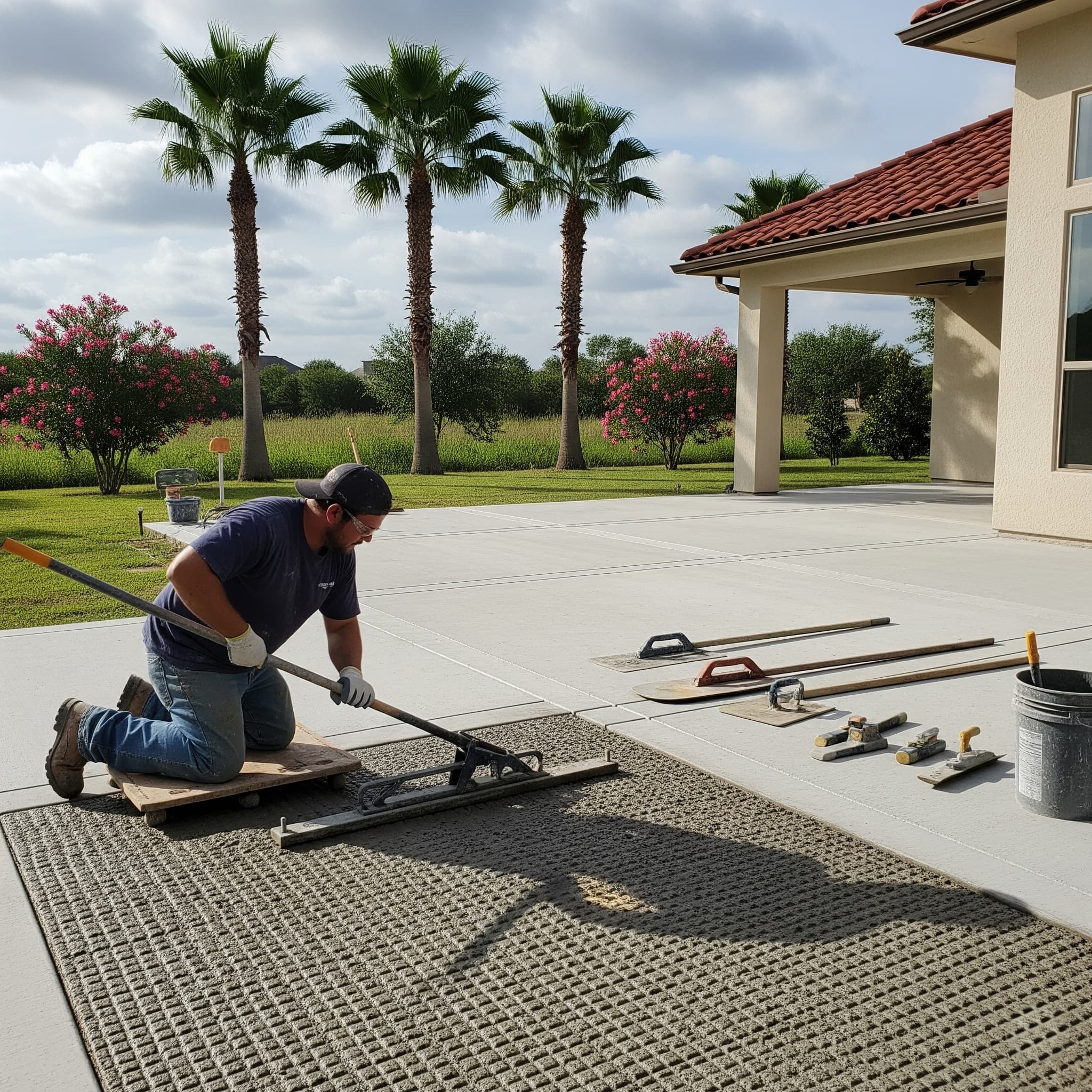
Quick Concrete Repair Tips to Handle Storm Damage in McAllen
Concrete Repair McAllen
Storm damage to concrete surfaces requires immediate attention in McAllen’s challenging climate. Intense rainfall, flooding, and severe weather events can cause significant damage to driveways, patios, walkways, and foundations. Understanding how to quickly assess and address concrete damage helps prevent minor issues from developing into major structural problems. This prevents the need for extensive professional intervention later. McAllen’s location in the Rio Grande Valley exposes properties to tropical storms and heavy rainfall events. Flooding can compromise concrete integrity through water infiltration, soil erosion, and thermal shock. Taking swift action with appropriate temporary and permanent repair solutions protects your property investment. It also ensures safety for family and visitors.

Immediate Storm Damage Assessment
The first priority after any storm event involves conducting a systematic assessment of concrete damage throughout your McAllen property. Begin with safety considerations by checking for standing water, electrical hazards, and structural instability. Only then should you approach damaged concrete areas.
Look for obvious signs of damage. These include visible cracks, displaced sections, and spalling, where the concrete surface has chipped away. Also, check for areas where soil erosion has undermined concrete support.
Document all damage with photographs from multiple angles. Note the size, location, and apparent severity of each issue. This documentation proves essential for insurance claims. It also helps contractors provide accurate repair estimates. Pay particular attention to foundation areas. Storm-related damage here can indicate more serious structural concerns requiring immediate professional evaluation.
Prioritizing Repair Urgency
Not all concrete damage requires immediate emergency attention. However, certain conditions demand prompt action to prevent safety hazards and progressive deterioration. Structural cracks in foundations represent high-priority repairs. Large sections of displaced concrete and areas where rebar is exposed also require professional assessment within days of discovery.
Moderate-priority issues include surface cracks and minor spalling. Cosmetic damage that doesn’t affect structural integrity falls into this category, too. These may allow water infiltration if left unaddressed.
Low-priority damage involves minor surface scratches and small chips. Discoloration can be addressed during routine maintenance schedules without immediate safety concerns.
Emergency Water Removal and Drying
Standing water around or on concrete surfaces accelerates damage progression. It must be removed quickly to prevent further deterioration. Use pumps, wet vacuums, or manual removal methods to eliminate standing water. Then focus on creating conditions that promote rapid drying.
Concrete is a porous material that absorbs significant amounts of water during flooding events. This requires active drying measures to prevent ongoing problems.
Establish air circulation using fans, dehumidifiers, and open ventilation. This accelerates moisture evaporation from concrete surfaces. Remove any debris, mud, or organic matter that can retain moisture and promote mold growth. The drying process for wet concrete begins with the removal of all standing water. It continues with controlling humidity levels to prevent further moisture absorption.
Preventing Secondary Water Damage
Once initial water removal is complete, implement measures to prevent additional water infiltration. Do this while permanent repairs are planned. Apply temporary waterproof coverings to cracked areas. Redirect drainage away from damaged sections. Monitor weather forecasts to anticipate additional protection needs.
McAllen’s subtropical climate means high humidity levels can prolong drying times. These conditions are favorable for mold growth in porous concrete. Use dehumidifiers to maintain indoor humidity below 50%. Ensure adequate ventilation to promote complete moisture evaporation from affected concrete surfaces.
Quick Temporary Crack Repairs
Temporary crack repairs provide immediate protection against water infiltration. They protect while permanent solutions are planned and materials are obtained. For hairline cracks less than 1/4 inch wide, clean the crack thoroughly with a wire brush. Remove loose debris, then apply a flexible concrete crack sealant. Choose one that remains waterproof while accommodating minor movement.
Larger cracks require more substantial temporary measures. These include hydraulic cement for quick-setting repairs or polyurethane sealants that expand to fill voids. These products set rapidly even in McAllen’s humid conditions. They provide effective temporary protection against further water infiltration. Always follow the manufacturer’s instructions for surface preparation and application timing.
Surface Preparation Techniques
Proper surface preparation proves critical for successful temporary repairs. These must withstand McAllen’s weather conditions until permanent solutions can be implemented. Remove all loose concrete, dirt, and debris. Use wire brushes, chisels, or pressure washing as appropriate for the damage severity.
For cracks wider than 1/4 inch, undercut the edges to create an inverted V-shape. This provides better mechanical bonding for repair materials. This technique helps temporary patches remain secure during the thermal expansion and contraction cycles common in our climate.
DIY Materials and Tools for Emergency Repairs
Maintaining basic concrete repair supplies helps address storm damage quickly. This works before professional help arrives or permanent repairs can be scheduled. Essential materials include hydraulic cement for quick-setting repairs. You’ll also need polyurethane crack sealant for flexible joints. Add concrete patching compound for surface repairs and waterproof membrane coatings for temporary protection.
Required tools include wire brushes for surface cleaning and chisels and hammers for crack preparation. You’ll need trowels for material application and protective equipment. This includes gloves, eye protection, and dust masks. Having these supplies readily available allows immediate response to storm damage. You won’t need to wait for store availability or delivery delays common after severe weather events.
Application Best Practices
Successful DIY concrete repairs depend on following proper application techniques. These should be adapted to McAllen’s climate conditions. Work during cooler parts of the day when possible to extend working time for repair materials. Avoid application during rainy conditions or when additional storms are forecast.
Apply repair materials in thin layers rather than attempting to fill large voids in a single application. Multiple thin applications provide better adhesion. They also reduce the likelihood of cracking as the materials cure. Allow each layer to cure according to the manufacturer’s specifications. Do this before applying additional material or exposing the repair to traffic.
Foundation-Specific Storm Damage
Foundation damage from storms requires immediate professional evaluation. However, homeowners can take steps to minimize further damage while waiting for expert assessment. Clear drainage areas around foundations to prevent water accumulation. Document any new cracks, settling, or displacement that occurred during the storm event.
Avoid attempting DIY foundation repairs beyond basic crack sealing. Improper repairs can mask serious structural issues. They can also interfere with professional assessment and permanent repair strategies. Focus on preventing additional water infiltration. Maintain drainage around foundation perimeters.
Soil Stabilization Around Foundations
Storm-related soil erosion around foundations can remove crucial support. It creates conditions for additional settling or movement. Replace eroded soil gradually using properly compacted backfill materials. Re-establish proper drainage grades that direct water away from foundation walls.
Monitor foundation areas for new cracks or movement in the weeks following storm events. Foundation problems often develop gradually as soil conditions change. Early detection allows intervention before minor issues become major structural problems requiring extensive repair.
When to Call Professional Help
Many surface concrete repairs can be handled by homeowners. However, certain types of storm damage require professional expertise to ensure safe and effective repairs. Structural cracks, foundation settlement, and extensive spalling warrant immediate professional evaluation. Damage involving exposed reinforcement steel also requires expert attention.
Professional assessment becomes essential when damage affects multiple areas of a property. It’s also necessary when temporary repairs fail to control water infiltration. Call professionals when homeowners lack confidence in their ability to properly diagnose and address the damage scope. The City of McAllen waives building permit requirements for flood-related home repairs for 90 days following storm events. This makes professional repairs more accessible during recovery periods.
Insurance Claim Considerations
Document all storm damage thoroughly before beginning any repairs. Insurance adjusters need clear evidence of the extent of damage and probable causes. Take photographs from multiple angles and measure crack dimensions. Maintain records of temporary repair measures undertaken to prevent additional damage.
Consult with insurance representatives before beginning extensive repairs. This helps you understand coverage limitations and required documentation procedures. Some temporary measures may be reimbursable under policy terms. Others might need pre-approval to maintain coverage eligibility.
Preventing Future Storm Damage
Once immediate storm damage is addressed, implement preventive measures. These reduce vulnerability to future weather events common in the McAllen area. Improve drainage systems around concrete surfaces. Seal joints and cracks before they allow water infiltration. Consider protective coatings that resist water penetration.
Regular maintenance helps concrete surfaces withstand storm impacts better than neglected installations. This includes crack sealing, surface cleaning, and drainage system upkeep. Schedule annual inspections to identify potential problem areas before they become vulnerable to storm damage.
For McAllen homeowners dealing with storm-damaged concrete, quick assessment and appropriate temporary measures protect property value. Do this while contractors arrange permanent solutions. Understanding when DIY repairs work appropriately and when professional help becomes necessary ensures both safety and effective restoration. When storm damage needs professional concrete repair, McAllen Concrete Contractors provides emergency response services. We offer permanent repair solutions designed for our challenging climate conditions.



